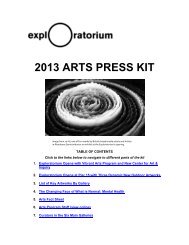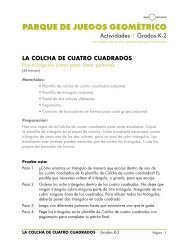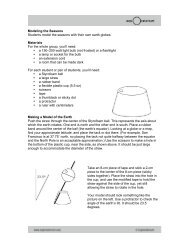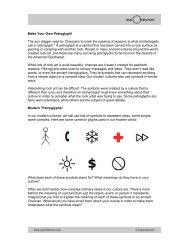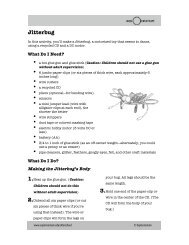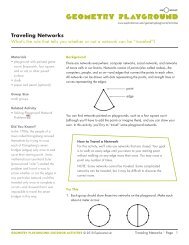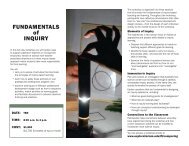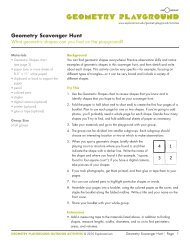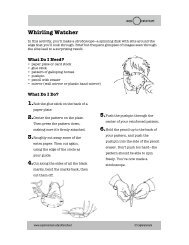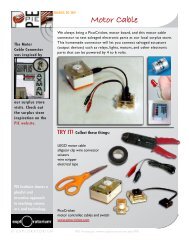Bottle Blast-Off - Exploratorium
Bottle Blast-Off - Exploratorium
Bottle Blast-Off - Exploratorium
You also want an ePaper? Increase the reach of your titles
YUMPU automatically turns print PDFs into web optimized ePapers that Google loves.
<strong>Bottle</strong> <strong>Blast</strong>-<strong>Off</strong><br />
In this activity, you’ll make a rocket launcher and a rocket, and investigate how<br />
rockets fly.<br />
What do I need?<br />
For the launcher:<br />
• 2-liter plastic bottle<br />
• 1/2-inch inner diameter flexible vinyl<br />
tubing (available at a hardware store);<br />
about 2 feet (60 cm) long<br />
• hair dryer (optional—to straighten out<br />
the vinyl tubing if it’s too curled to work<br />
with)<br />
• tape (vinyl tape, masking tape, duct tape,<br />
electrical tape)<br />
• 1/2-inch inner diameter PVC pipe (also<br />
available at the hardware store); 1 foot<br />
(30 cm) long<br />
For the rocket:<br />
• 8 1/2" ! 11" sheet of construction paper or card stock<br />
• transparent tape<br />
• scissors<br />
• index card<br />
• ruler<br />
• pencil<br />
What Do I Do?<br />
Building the launcher<br />
1. Remove the cap from bottle.<br />
2. Cut about two feet of vinyl tubing.<br />
(If the tubing is tightly curled,<br />
you can heat it with a hair dryer<br />
and straighten it out.)<br />
3. Put the vinyl tubing into the neck<br />
of the bottle and create a tight<br />
seal with the tape so air can’t<br />
escape. Use a generous amount of<br />
tape.<br />
www.exploratorium.edu/afterschool ! <strong>Exploratorium</strong>
4. Put the other end of the vinyl<br />
tubing just up against the PVC<br />
pipe and,<br />
Building the Rocket<br />
1. Make a tube by wrapping the<br />
paper the long way loosely<br />
around the PVC pipe. Then slide<br />
the tube off, making sure not to<br />
tighten it.<br />
2. Using transparent tape, tape the<br />
tube along the seam.<br />
3. Make a point at the top of the<br />
rocket. First flatten the tube at<br />
one end. Then, using your<br />
scissors, cut the flattened part<br />
You can use the rocket as is, or add fins to the rocket.<br />
To add four fins<br />
1. Take a 3 x 5 index card, fold it in<br />
half, open it at the fold, then cut it<br />
along the fold into two pieces.<br />
2. Using the ruler, draw a diagonal<br />
line from corner to corner on<br />
using tape, make an airtight seal.<br />
into a point. You could also cut it<br />
just shy of a sharp point.<br />
4. Make a tight seal on the point<br />
with transparent tape to prevent<br />
air from escaping.<br />
each piece of the card, then cut<br />
along those lines to form four fins.<br />
3. Tape the fins to the bottom of the<br />
rocket so that the distances<br />
between them are equal. Put a fin<br />
www.exploratorium.edu/afterschool ! <strong>Exploratorium</strong>
flat against the rocket and tape it,<br />
then bend it flat to the other side<br />
Flying the Rocket<br />
1. Slide your rocket about halfway<br />
down the PVC pipe.<br />
2. Put the bottle on the ground.<br />
3. Hold the PVC pipe with the rocket<br />
on it and point it upwards or<br />
away from people.<br />
and tape it again.<br />
4. Step on the bottle and watch your<br />
rocket fly!<br />
Note: If the bottle flattens out, curve your hand around the top of the PVC pipe<br />
and, resting your lips against your hand (not the pipe) blow into it. This should<br />
reinflate your bottle so you can blast off again. It’s a good idea to have some extra<br />
bottles on hand, though, in case that doesn’t work.<br />
What’s Going On?<br />
As a rocket travels, air is forced to move around it. Because of the rocket’s pointed nose,<br />
the air can change direction smoothly and gradually, so it doesn’t strongly resist the<br />
movement of the rocket. If the nose of the rocket were flat, the air would have a harder<br />
time moving around it, so the rocket would be confronted with a much greater resistance,<br />
and it would fly less far. Fins on the back of a rocket give it stability so it will fly straight.<br />
www.exploratorium.edu/afterschool ! <strong>Exploratorium</strong>




